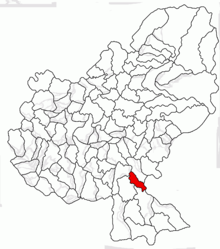Vețca
|
Vețca Vitzka Székelyvécke |
||||
|
||||
| Basic data | ||||
|---|---|---|---|---|
| State : |
|
|||
| Historical region : | Transylvania | |||
| Circle : | Mureș | |||
| Coordinates : | 46 ° 21 ' N , 24 ° 47' E | |||
| Time zone : | EET ( UTC +2) | |||
| Height : | 379 m | |||
| Area : | 37.49 km² | |||
| Residents : | 892 (October 20, 2011) | |||
| Population density : | 24 inhabitants per km² | |||
| Postal code : | 547640 | |||
| Telephone code : | (+40) 02 65 | |||
| License plate : | MS | |||
| Structure and administration (as of 2016) | ||||
| Community type : | local community | |||
| Structure : | Vețca, Jacodu , Sălașuri | |||
| Mayor : | Pál Fekete ( UDMR ) | |||
| Postal address : | Str. Principală nr. 140 loc. Vețca, jud. Mureș, RO-547640 |
|||
| Website : | ||||
Vețca [ ˈvet͡ska ] ( German Vitzka , Hungarian Székelyvécke ) is a municipality in the Mureș district , in the Transylvania region in Romania .
The place Vețca is also known under the Hungarian name Vécke .
Geographical location
The municipality Vețca is located in the Kokel Valley (Podișul Târnavelor) in the Transylvanian Basin . Veca is located on the creek of the same name and the district road (Drum județean) DJ 134, 15 kilometers south of the small town Sângeorgiu de Pădure (Sankt Georgen auf der Heide) and about 40 kilometers southeast of the district capital Târgu Mureş (Neumarkt am Mieresch) .
history
The place Vețca was first mentioned in 1301. After the Reformation , the Hungarian aristocratic Horváth family convinced the Unitarian village population to convert to Catholicism in the 18th century .
A settlement on the territory of the municipality Vetca is on the site Cetate (Váruta hegy) of the unincorporated village Jacodu (Hungarian-Sacken) to the early history dates back. Archaeological finds on the area of the incorporated village are assigned to the Neolithic and Bronze Age . In the area of the incorporated village of Sălașuri ( Székelyszállás in Hungarian ), archaeological finds made of silver were ascribed to the era of the Great Migration and in the area of Vețcas to the Bronze Age.
In the list of historical monuments of the Romanian Ministry of Culture and National Heritage, finds of a settlement in the incorporated village of Sălaşuri near Cărămidărie (Hungarian Teglas dülo ) date back to the Latène period.
In the Kingdom of Hungary , places of today's municipality belonged to the Homoród chair district in the Udvarhely County and then to the historical Odorhei district and, from 1950, to the present-day Mureș district.
population
The population of Vețca municipality developed as follows:
| census | Ethnic composition | ||||
|---|---|---|---|---|---|
| year | population | Romanians | Hungary | German | other |
| 1850 | 2.010 | 89 | 1,920 | - | 1 |
| 1941 | 2.224 | 32 | 2.165 | - | 27 |
| 1992 | 972 | 22nd | 905 | - | 45 |
| 2002 | 862 | 13 | 785 | - | 64 |
| 2011 | 892 | 12 | 757 | - | 123 |
The highest number of inhabitants has been recorded in the area of today's municipality since 1850 and that of the Magyars in 1941. The highest number of Romanians was registered in 1850, Roma (98) in 2011 and Romanian Germans (11) in 1910.
Attractions
The Roman Catholic Church built in 1741 in the community center is worth seeing ; it is a listed building, otherwise there is no noteworthy object to be mentioned in the area of the community.
Web links
Individual evidence
- ↑ 2011 census in Romania ( MS Excel ; 1.3 MB)
- ↑ Arcanum Kézikönyvtár: Historical-administrative book of place names of Transylvania, Banat and Partium. Retrieved April 15, 2019 (Hungarian).
- ↑ Heinz Heltmann, Gustav Servatius (Ed.): Travel Guide Siebenbürgen . Kraft, Würzburg 1993, ISBN 3-8083-2019-2 , p. 517 .
- ^ Institute of Archeology - Jacodu , accessed April 24, 2019 (Romanian).
- ↑ Institute of Archeology - Sălaşuri , accessed on April 24, 2019 (Romanian).
- ^ Institute of Archeology - Vețca , accessed April 24, 2019 (Romanian).
- ↑ a b List of historical monuments of the Romanian Ministry of Culture, updated 2015 (PDF; 12.7 MB; Romanian).
- ↑ Censuses 1850–2002, last updated November 2, 2008 (PDF; 1 MB; Hungarian).





